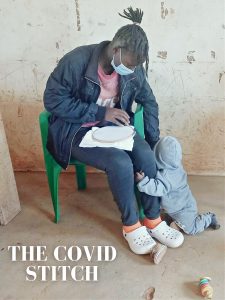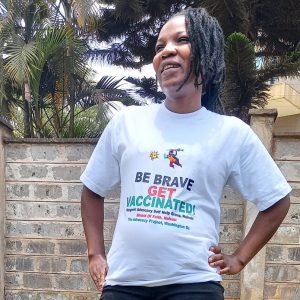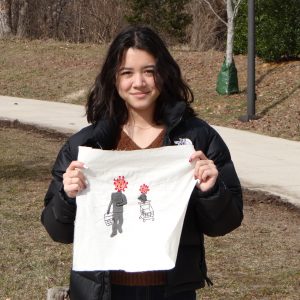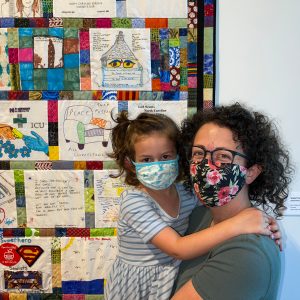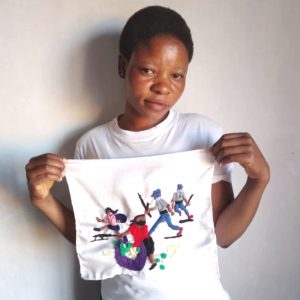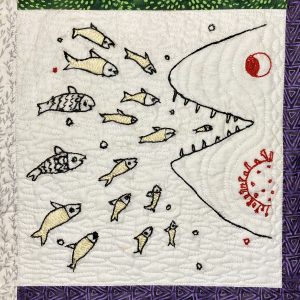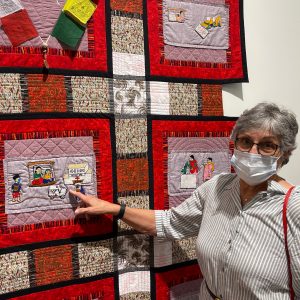ADVOCACYNET 398, October 4, 2023
Quilts Capture the Terror and Heroism of COVID-19
Over 200 women and girls from six nations have used embroidery to describe the devastating impact of COVID-19 on their families and communities.
Their stories, from the US, Bangladesh, Zimbabwe, Nepal, Uganda and Kenya offer a graphic and deeply personal account of a terrifying pandemic that has so far claimed almost seven million lives.
The stories make it clear that marginalized communities which suffered from inadequate health services before the pandemic have been especially vulnerable. But they also show how stitching in a group can empower women during a crisis and inspire communities to take action for change. Several artists have described their stories as an “act of resistance” against the virus.
The stories have been assembled into quilts by 14 well-known quilters in the US and will be displayed at The George Washington University Museum and The Textile Museum October 13-14. Entitled The COVID Stitch, the exhibition comes with a 194-page catalogue available from The Advocacy Project (AP).
*
The COVID Stitch was launched in the spring of 2020 as the pandemic began its global march. AP commissioned stories from several partner organizations in the Global South as well as two new partners in the US – a team of students at the Wakefield High School in Arlington (Virginia) and the Cameron Art Museum in Wilmington, North Carolina.
The first stories came from three women in Nepal whose fathers disappeared during conflict and described the shattering impact of COVID-19 on community and family life among the Tharu people.
One image by Kushma Chaudhary shows an elderly couple resigned to death while a bulldozer dumps the bodies of COVID victims into a nearby pit. Family members were forbidden to attend COVID burials, which was considered deeply offensive in Tharu culture.
The same theme was echoed by Stella Makena in Kenya, who depicted a COVID victim being surreptitiously buried at night in the informal settlement of Kibera, Nairobi. Another poignant story by Anne Kihiu, from the settlement of Kangemi, entitled Grief, shows Anne sobbing beside the grave of her beloved father with the caption “I have lost my best friend.” Kenyan artists made 44 stories for The COVID Stitch.
*
Many stories show how COVID-19 deepened the economic plight of communities that were already impoverished before the pandemic. River Gypsies on the island of Mayadip in Bangladesh, who earn the equivalent of 40 US cents a day, found the mainland market for their fish suddenly closed off. Their desperation is described through 21 exquisite but disturbing images.
Several governments responded to the pandemic by imposing a harsh lock-down out of concern that the virus would spread unchecked through under-served communities, but this only increased pressure on the poor. This is graphically depicted by ten young artists from Zimbabwe, who show police preventing women from collecting water and arresting families for violating the curfew when they went in search of food.
Such actions created a sense of inequity, and this intensified as vaccines became available to the rich and privileged but not communities like Kangemi in Nairobi that lacked the facilities to even store vaccines.
Mayadip Island in Bangladesh is so remote that the island has never had a health center. This made it impossible to estimate how many River Gypsies had succumbed to COVID-19, let alone offer treatment, testing or vaccinations.
*
Although The COVID Stitch reflects deep sadness and frustration, many stories pay tribute to the heroism of health workers and dedication of volunteers.
Kyle Horton and Mimi Marquis in Wilmington launched a network of quilters who made 10,000 masks at the height of the pandemic, and used their two stories to hail these “superheroes.” Ms Marquis even attached a mask to her block as a rebuke to Americans who refused to wear masks. The Wilmington stories were assembled into three quilts by Bobbi Fitzsimmons, who coordinates AP’s quilting program.
Many images are quirky and ingenious. The Greedy Virus, by Rheka in Bangladesh, depicts the virus as a huge fish gobbling up fishermen. Virus on the Retreat by Abigael Kwamboka in the Kenyan settlement of Kangemi shows a determined needle in hot pursuit of the virus.
Paranoia, by Kate Lanman at the Wakefield High School, reflects Kate’s fear of being infected in supermarkets. Several other Wakefield stories express regret at missing out on cherished high school traditions like the Homecoming. But the artists are also relieved to get some respite from a busy school schedule and have the time to appreciate friends and families.
*
Several artists involved in The COVID Stitch have described the project as empowering because it offered them a creative outlet for their frustration and a chance to socialize with friends.
Dorothy Thomas and her daughter Sadie, 5, from Wilmington used their story to record their disappointment at having to cancel Sadie’s birthday party. While this was hardly life-threatening, Ms Thomas echoed other artists in describing the act of stitching as “act of resistance” against the COVID-19. She also said she had been heartened to see her story included in a large quilt and displayed at the Cameron Art Museum in Wilmington in April 2021.
The COVID Stitch has also shown how stitching can build social capital and mobilize women. The artists from Kangemi in Nairobi formed deep friendships during the story-telling and set up a group to demand better services in the settlement. They then printed Abigael Kwamboka’s iconic image of a needle on tee-shirts and launched a campaign that would secure almost 2,000 vaccinations in Kangemi.
Stitchers from the Kibera settlement in Nairobi also formed a new association, Shield of Faith, to compost food waste and produce vegetables through kitchen gardens, with support from The Advocacy Project.
These and other initiatives are still linked to stitching. Many of those who contributed stories for The COVID Stitch have become accomplished seamstresses and are selling embroidery through Southern Stitchers, an online store created by AP. The store has raised over $2,485 for 41 COVID artists so far this year.
*

